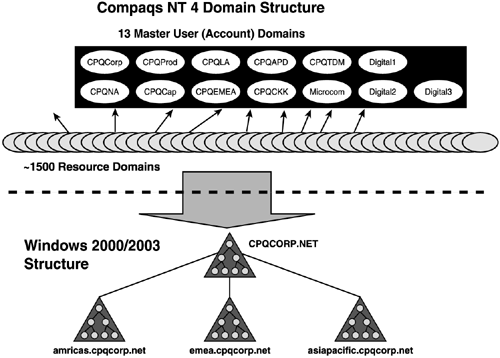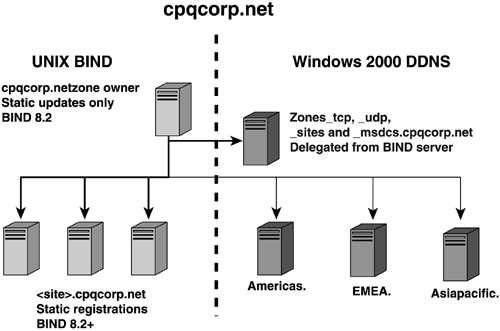Hewlett-Packard Company (HP)
To describe this migration, we have to go back prior
to HP's merger with Compaq. Compaq had nearly completed its migration
from Windows NT to Windows 2000 when the merger took place. HP, on the
other hand, was still in a Windows NT environment in the midst of
finalizing its own plans to migrate to Windows 2000. Further, Compaq
wanted to draw a tighter connection between the domain infrastructure
and the mail and messaging structure, and its migration included
migration to Exchange 5.5.
Compaq's Windows NT environment, due to its
acquisition of Digital Equipment Corp, Tandem, and others, consisted of
13 master user domains, and about 1,700 resource domains. The company
spent considerable time designing the Windows migration and the
infrastructure to support a Windows 2000 environment. The new domain
structure was a single forest, with a single domain tree, including a
single parent—cpqcorp.net—and three child domains—Americas.cpqcorp.net,
asiapac.cpqcorp.net, and EMEA.cpqcorp.net. Figure 7 shows the dramatic change from the Compaq Windows NT structure to the new Windows 2000 structure.

The DNS structure is an interesting study. Starting
as many companies do, with a UNIX BIND DNS, Compaq decided on a couple
of points for the new namespace:
The Windows 2000 namespace was to be cpqcorp.net.
The
company would not permit dynamic registrations on the BIND server
because it didn't want to maintain dynamic records on the root server.
The BIND server would not dynamically register host records from the Win2K forest.
To accomplish these three goals, Compaq created a
Windows 2000 DNS and had the BIND server delegate the _msdcs, _sites,
_tcp, and _udp zones to a Windows 2000 DNS. The BIND server then
delegated the Americas.cpqcorp.net, EMEA.cpqcorp.net, and
AsiaPac.cpqcorp.net zones to DNSs for each of those domains, as shown in
Figure 8.

Compaq employed a restructure migration method. The
company built the 4-domain structure, set up the OU structure, defined
policies, and so on prior to any live data (users, and so on) being
introduced into the domain. Using a third-party migration tool, Compaq
then migrated the user accounts from the 13 Windows NT MUDs to the
appropriate geographical domain.
Resource Domain Migration
The 1,700 or so resource domains were migrated with two primary goals in mind:
All resource domains would eventually be
collapsed into various OUs in the Windows 2000 forest, unless there was a
critical technical or business need that dictated otherwise.
Member servers of resource domains would be upgraded to Windows 2000 whenever possible.
The mechanisms used for migration of nearly 1,700
resource domains varied. For instance, a large number of Windows NT
resource domains existed purely for improving browsing performance and
providing a home domain for desktop systems. In these cases, the servers
were joined to the appropriate domain in the forest and their DCs were
retired. Domains that supported file and print services consisted of all
DCs. In those cases, Compaq either upgraded the hardware and used the
servers in the new Windows 2000 domain, or if the hardware was not worth
upgrading, Compaq transferred the data and retired the server. Because
all servers were DCs, to move them to the Windows 2000 domains, Compaq
used the Upromote utility (a third-party utility that allowed demotion
of Windows NT 4.0 DCs) to demote the DCs. They were then upgraded to
Windows 2000 and joined to the appropriate Windows 2000 domain. This
continued in each resource domain until no more DCs were left,
destroying the domains.
Domains that hosted infrastructure servers, such as
DNS and DHCP, had their servers retired as their function was taken over
by other Windows 2000 servers, eventually collapsing those domains.
Finally, domains that hosted application services were handled on a
case-by-case basis, upgrading or retiring the servers based on the life
expectancy and cost of upgrade versus cost of the new hardware, or as a
natural consequence of server consolidation, application retirement, and
other factors.
In this process, hundreds of servers were retired.
They were distributed to other organizations that used them for
departmental file and print servers, lab machines, and so on. Even if
servers are at the end of useful life for your production
infrastructure, they still have many years left for other organizations
in the company that could use them for
Departmental file and/or print servers
Departmental Web servers
Lab machines
Test machines for developers
Training Labs
Help Desk labs for problem reproduction
Work-from-home
employees. Servers that have a gigabyte of memory, combined with a
virtual server product, such as VMWare Workstation or Microsoft's
Virtual PC, can use these machines to host multiple virtual servers on
one piece of hardware, saving on space, power bills, hardware
maintenance, and so on and allowing the user to build an infrastructure
on one server.
tip
I successfully taught Windows Server 2003 AD training
courses to HP employees using machines with 1GB RAM and a 40GB hard
disk using VMWare. I configured each virtual machine with 160MB of RAM
(although Microsoft says it should be 256MB). You can network them using
Network Address Translation (NAT) (host becomes a NAT server, and
issues 192.168.x.y addresses to the clients), Bridged (allows access to
the network that the host machine is on), and Host Only so the virtual
machines can see the host and each other, but no other external
machines.
This configuration allowed me to run five virtual
machines on each physical computer, so I could install a parent-child
domain forest with two DCs in each domain and a member server we could
move as a client wherever we needed it. VMWare's new release of
Workstation v4.5 allows the use of more than 1GB of RAM, so you can set
up a decent-sized infrastructure on a single computer. Microsoft has a
competing product, Virtual PC, which permits this same functionality.
Both VMWare and Microsoft have server-based products
that allow a single host to host multiple servers for production
purposes and allow server consolidation. The workstation product is good
for testing and training, but not for production uses.
User Migration
Compaq divided the nearly 90,000 users up into stages
and developed a Web application for the users to use to do their
migration. The users would get an e-mail from IT giving them a certain
period of time to go to this Web site, fill out the form, and then take
steps to migrate their desktop machines. The user migration took more
than two years.
When HP acquired Compaq, the decision was made to
migrate the HP user accounts and adopt the Compaq namespace,
Cpqcorp.net, because HP was still using a Windows NT domain structure at
the time. Of course, the cpqcorp.net name didn't reflect HP, so at the
time of this writing HP is considering doing a Domain Rename. To make
the user migration as simple as possible and realizing a huge potential
for duplicate names, HP decided to append a number to the actual user
account names of all the premerger HP accounts, so JBloe became JBloe-1.
Resolving friendly names was as before, appending some distinguishing
characteristic such as the site code, the organization the user belonged
to, and so on so they could be distinguished in the Global Address List
(GAL).
Compaq's Exchange 2000 organization and HP's Exchange
5.5 organizations were connected using Simple Mail Transfer Protocol
(SMTP) routing, along with the necessary network routing so that the day
the merger was finalized, all employees from both companies showed up
in the GAL and could send and receive e-mail. After all mailboxes are
moved, the premerger HP Exchange 5.5 organization will be decommissioned
and all employees will be able to share calendar information, share
free/busy information, delegate mailbox access, and access the same set
of Public Folders.
Migration to Windows Server 2003
As a member of Microsoft's Joint Development Program
(JDP), HP had been testing Windows Server 2003 and found some exciting
features that were so compelling, a business justification was never
performed.
Having tested Windows Server 2003 beta and working
closely with Microsoft, HP deployed Windows 2003 RC1 on production DCs
in October 2002, and then RC2 (the final beta release before RTM). By
February 2003, all 154 production DCs/GCs were upgraded to Windows
Server 2003, and 57 member servers running VPN, Remote Access Service
(RAS), Exchange, and Windows Internet Naming Service (WINS) were
upgraded to 2003 for the largest Windows Server 2003 deployment outside
of Microsoft. By early March 2003, all domains were raised to functional
level Windows Server 2003 (native) and then the forest functional level
was raised as well.
The interesting point is that HP was running Windows
Server 2003 on production DCs with beta code. Keep that in mind if you
wonder if Windows Server 2003 is stable or if you need to wait for the
first Service Pack.